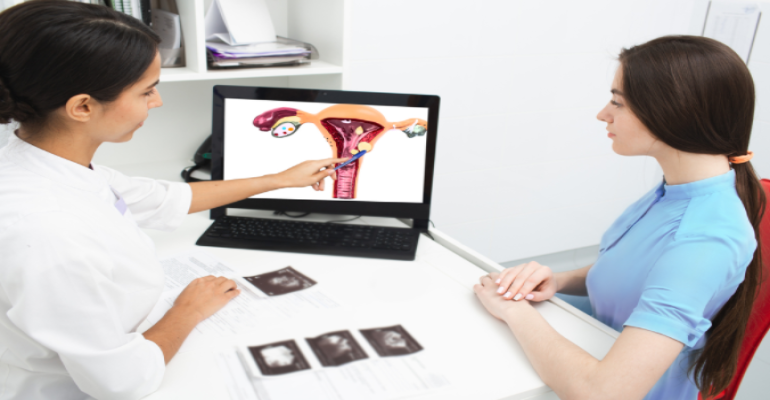Ovarian cysts, a common problem in women, arise due to hormonal imbalances in the body and can cause various health issues. Although the vast majority are benign, they must be regularly monitored considering the possibility of turning cancerous.
To fully understand ovarian cysts, it is important to first understand the ovary, which is part of the female reproductive system.
What is the Ovary?
The ovary is a female reproductive organ containing female reproductive cells (eggs). It is one of two symmetrical glands located on each side of the uterus. Present in girls even before birth but not producing eggs until puberty, this organ allows eggs to reach the uterus on certain days of each month. The ovulation process, known as ovulation, occurs between the 11th and 16th days of the menstrual cycle, roughly the middle of the cycle.
This cycle, seen in every healthy woman, continues until menopause. The release of the egg from the follicle, the sac in which the egg is contained, into the fallopian tubes is very important for couples expecting pregnancy.
During ovulation, the eggs in the fallopian tubes, which open into the uterus, meet with sperm to fertilize and form an embryo. This marks the first step of pregnancy.
Why Do Ovarian Cysts Occur?
The primary cause of cyst formation in the ovaries is hormonal imbalance. The ovulation process, where follicles mature and release an egg, depends on delicate hormonal balances. If there is a disruption in the hormones regulating ovulation, the follicles do not mature properly and do not release an egg.
Follicles that do not rupture over time become cysts, causing ovarian cysts. This creates a domino effect, turning into a vicious cycle, as cysts formed due to hormonal disorders cause further hormonal imbalance. At this point, the only solution is medical treatment.
What Types of Ovarian Cysts Are There?
Simple cysts: Usually benign and often disappearing on their own, simple cysts occur due to fluid accumulation within the follicle. These cysts have clear borders and are about 1 to 4 centimeters in diameter.
Follicular cysts: These cysts occur when the egg cell does not rupture and typically resolve spontaneously after menstruation.
Polycystic ovary cysts: When ovulation is irregular, the ovaries enlarge and contain many eggs. Although called cysts, there is no real cystic structure. This condition disrupts the menstrual cycle and can cause male-pattern hair growth on the body.
Corpus luteum cyst: This cyst forms after ovulation when the tissue in the egg cell transforms into corpus luteum tissue. It usually resolves after menstruation.
Endometrioma (chocolate cyst): Endometrioma is a layer of tissue that lines the inside of the uterus. When this tissue is present on the ovaries, cysts form. These cysts may contain various tissues and can cause severe abdominal pain and infertility.
Serous cystadenoma: This type of cyst is most common in women of reproductive age and can grow up to 5-15 centimeters. Treatment is only possible with surgery.
Mucinous cystadenoma: This cyst type does not disappear on its own and can reach very large sizes, approximately 15-50 cm. Surgical operation is required for treatment.
What Are the Symptoms of Ovarian Cysts?
- Irregular menstruation,
- Severe menstrual pain,
- Longer or shorter menstrual bleeding than usual,
- Digestive system problems,
- Severe pain in the groin,
- Swelling in the abdominal area,
- Urinary complaints,
- Nausea and vomiting,
- High fever,
- Infertility,
- Pain during sexual intercourse,
- Male-pattern hair growth.
How Are Ovarian Cysts Diagnosed and Treated?
Ovarian cysts are usually detected during routine check-ups. Ultrasound examinations are done via abdominal or vaginal routes. Whether detected masses are benign or malignant is determined through ultrasonography, gynecological exams, MRI, and blood tests. Blood tests include markers such as Ca-125, AFP, Beta-hCG, CEA, and CA 19-9, which are important indicators of cancer.
There are different approaches to treating ovarian cysts;
- Observation: Since most cysts resolve spontaneously, observation is the first step. Therefore, in patients without symptoms, follow-up treatment is usually preferred.
- Medications: Birth control pills can be used to help reduce ovarian cysts.
- Surgery: The most definitive way to determine if cysts are benign or malignant is through biopsy and pathology. If the mass is solid, hard, immobile, and larger than 10 cm, it should be surgically removed due to cancer risk. If the mass is smaller than 6 cm, without adhesions, smooth, mobile, and shows no growth, it is monitored. Surgery is generally not required. Ultimately, cyst treatment is individualized based on the patient's symptoms and cyst characteristics.
We wish you healthy days.


